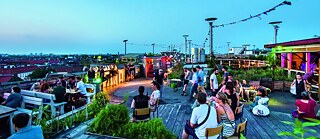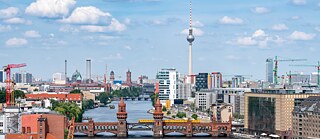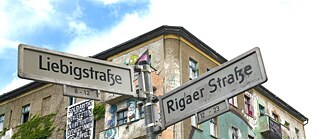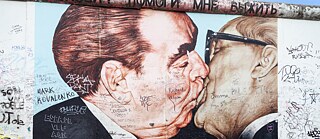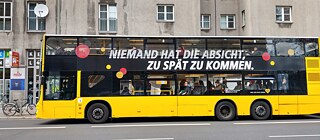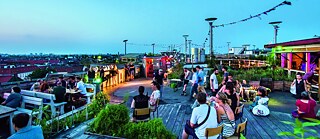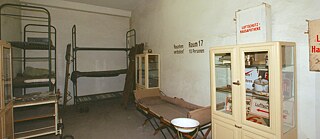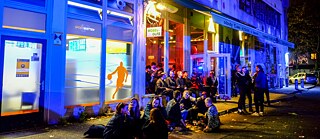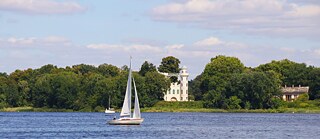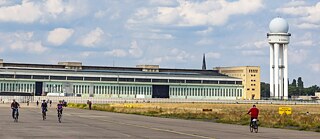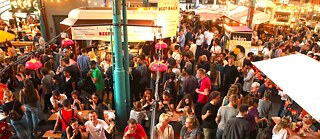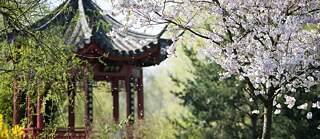Berlin has a reputation for being loud, non-conformist and just a bit rude. Our author Nele Jensch looks into what the German capital is really like as she takes readers on a tour of the city where you can see more in one go around the block than elsewhere over the course of year.
By Nele Jensch
High in the sky
The television town numbers among the tallest buildings in Germany and dominates the German capital’s skyline | Photo (detail): © Adobe
All roads lead to it – or more accurately all sight lines: The television tower at Alexanderplatz is the most recognizable part of Berlin’s skyline. It is the tallest tower in Germany and the ball around its middle makes it absolutely unmistakable. The tower opened in 1969 in celebration of the DDR’s (German Democratic Republic) 20th birthday and was designed to showcase the country’s power. Today the view from the panorama deck in the ball provides a fantastic look at the city from above. In the rotating restaurant one floor up, 40 tables secured to the floor offer an ever-changing view as guests enjoy drinks and a meal. The television tower has a prominent place in Berlin folklore, of course, and even baby rattles and biscuit cutters feature its silhouette. Despite the numerous rumours you might hear, Berlin residents do not have a nickname for the tower. The “Telespargel” (teleasparagus) name the DDR government tried to push never really caught on.
Open spaces under threat
Occupied buildings still exist in Berlin and many people involved in the arts are helping preserve left-wing counter culture. | Photo (detail): © picture alliance/Paul Zinken/dpa
In the 1980s and 1990s, Berlin was at the heart of the squatters’ movement. Some of the housing projects established back then are still around today. The best known of these is the apartment complex at number 94 Rigaer Straße in Friedrichshain. The Kadterschiede bar on the ground floor has not had a rental contract since its squatting days, but so far all eviction attempts have failed. Right around the corner is the “anarchist-queer-feminist” housing project Liebig34, another symbol of Berlin’s left-wing scene. Many of these projects have just about run their course though, and Liebig34 is currently battling an eviction order. A number of well-known people have spoken out in favour of the Bohemian housing and cultural project as part of the “Kein Haus weniger” (Not a single building less) initiative. Those who feel the project is important to Berlin publically, socially and culturally include artists like Nobel Prize laureate Elfriede Jelinek, singer-songwriter Nina Hagen and band Element of Crime. While the squatter scene fights for its life, other Berlin residents are taking back public spaces in different ways. The Holzmarkt (Wood Market), for example, is a creative village on the banks of the Spree River in Freidrichshain, and seen as a model of alternative urban planning. A number of urban gardening collectives are turning the city green, like the Prinzessinnengärten (Princess Gardens) at Moritzplatz, where anyone can plant and harvest their own vegetables. And every week hundreds turn up to listen to and sing karaoke in Mauerpark (Berlin Wall Park) every week.
Traces of a divided city
Traces of the once divided republic are still omnipresent in Berlin – segments of the Berlin Wall are tourist attractions today. | Photo (detail): © Adobe
Speaking of walls, the Berlin Wall has left indelible and visible marks on the city. There is the Berlin Wall monument, which stretches along over 1.4 kilometres of the former border and is the central memorial to those who lost their lives trying to escape across the border. The DDR’s secret police had a prison in in Hochenschönhausen that is also a memorial today. The popular East Side Gallery is open 24/7, a draw for tourists who enjoy taking selfies in front of a segment of the Berlin Wall colourfully painted by artists. Even this landmark is not safe from development and corporate interest and segments of the wall memorial have been moved to make space for hotels and luxury flats directly on the banks of the Spree River. If you pay attention as you walk through the city, other traces of Berlin’s past as a divided city are visible in addition to the memorials. There is the Mauerband (Berlin Wall Beltline) that snakes through the entire city, marking the wall’s course with cobblestones. Visitors who want to trace the wall’s path around what was West Berlin can follow the Mauerweg (Berlin Wall Path), an around 160-kilometre cycling and walking path that traces a route past the posts where DDR border troops were once stationed.
BVG: public transport with a cult following
Never at a loss for a snappy line: the BVG’s slogans and campaigns have achieved cult status. | Photo (detail): © picture alliance/Wolfram Steinberg/dpa
If you’ve ever wondered how a run-of-the-mill public transport authority attracts a cult following, the answer is fairly obvious: the right marketing. The capital’s Berliner Verkehrsbetrieben (Berlin Public Transport Services, BVG) managed this with flying colours with their “Weil wir dich lieben” (Because we love you) social media campaign. With a heaping helping of self-irony and cheeky sayings about buses right behind each other along the same line, over-filled, dirty undergrounds and late arrivals and by poking fun at almost every cliché about Berlin under the sun, the BVG succeeded in turning the frustration many Berlin residents feel about their public transport system into a hate-love at least. The #weilwirdichlieben team also braved political statements wrapped in humour about hot-button topics like climate change, homophobia, racism, and sexism. They even poked fun at the FDP political party: “We have so much in common: yellow and striking, and taxes are our favourite topic.” The BVG has stayed true to its motto “whether you’re busexual or tramgender: we don’t care who you love, because we love you!” The campaign included some fun marketing gags too, like the trainers sold as an annual pass for the underground, busses and trams in 2018. Quite a few proud Berlin residents camped out in front of stores (in winter mind you) to be the first to snap up the limited edition footwear. The next coup will be the BVG’s application to UNESCO for world heritage status, After all, what could be more intrinsic to Berlin than short-tempered drivers and tried-and-true tricks, like rubbing a coin the automatic ticket machine spit back out against the side of said machine.
Green oasis above the roofs of Neukölln
Bar with a view: enjoy a panoramic look at the entire city from Klunkerkranich. | Photo (detail): © picture alliance/Sabine Lubenow/DUMONT Bildarchiv
A conventional shopping centre with a green, oasis crown: the roof garden and event location Klunkerkranich floats above the Neukölln Arcades. The roof bar features comfy wooden furniture, cloth bunting and green dotted about in pots, raised beds and recycled bathtubs. By now the Klunkerkranich name has spread beyond the bounds of Neukölln thanks to an entry in Lonely Planet and it is correspondingly crowded. Especially in the height of summer, a visit is still a highlight as you watch the sun set in the coolness of a light, evening breeze with Berlin spread out at your feet as a reward for making the climb.
Berlin from below
Tour Berlin “from below” and see what the inside of a bunker looks like. | Photo (detail): © picture alliance/Bernd Settnilk/ZB
Berlin is notorious for its underground parties, quite a few of which have taken place in former air raid bunkers from World War II. The bunkers are also accessible during daylight hours where visitors can catch a glimpse of the city’s history. Berlin Unterwelten (Berlin Underworlds) offer tours through the innumerable WWII bunkers and the “civil protection units” the old bunkers of West Berlin were converted to during the Cold War to protect residents during a nuclear attack. One very special former bunker is close to Anhalter Train Station. A sign above the entrance to the “Berlin Story Bunker” warns all visitors, “those who build bunkers will also drop bombs.” Inside, or more accurately down below, authors Wieland Giebel and Enno Lenze have curated a unique collection designed to answer the eternal question “Hitler – how could it have happened?”, including an exact replica of the “Führerbunker”. In the beginning, critics predicted the attraction’s designers would fail across the board. Today though, over 200,000 people from all over the world come to see the bunker every year and Israel’s ambassador once praised the exhibit. The bunker is also a symbol of democracy and human rights, as evidenced when Lenze and his team raised the perhaps largest rainbow flag in Germany just in time for Berlin’s Pride Week. In another bunker, this one above ground in Berlin Mitte, art is on display instead of history. It was purchased by a private individual and the cement giant houses the Boros Collection, a unique collection of contemporary art.
The nights are long in Kreuzberg...
Between Kottbusser Tor and Schlesisches Tor train stations is probably one of the best places in the whole city to party. | Photo (detail): © picture alliance/Stefan Jaitner/dpa
…as the Blattschuss brothers sang back in the 1970s. Not much has changed in the intervening years and the area between the Kottbuser Tor and Schlesisches Tor train stations is a good spot to party. On Lohmühlen Island, for example, in the Birgit&Bier beer garden where merrymakers dance among the carousels and auto scooters, or in clubs IPSE and Burg Schnabel. Popular club Visionäre, where visitors could sit on the wooden pier and dip their toes in the Landwehr Canal, partially burned down in summer 2019. Luckily nearby Festsaal Kreuzberg and the Hoppetosse party ship are there to make up for this loss. Other parts of Berlin provide attractive nightlife as well. Berlin’s special location for ecstatic partying, the Berghain, is located in Friederichshain, as is the RAW compound which features numerous clubs. In Neukölln, on the other hand, techno club Griessmühle was evicted from its premises because the owner plans to tear the building down. So Griessmühle was granted temporary asylum in Berlin’s Mitte and Lichtenberg quarters. Hedonism will always have a place in Berlin, for the moment at least, though more and more clubs are being forced out of the city because buildings are being sold out from under them, new buildings are going up and rental contracts are not being extended. The clubs are falling victim to their own hype, since techno culture has made the city more attractive for young, hip people and investors alike. These days the citizens fighting to save Berlin’s night clubs are getting some support from the government, which is calling for the preservation of this unique cultural heritage of Berlin.
Lots of green and culture in West Berlin
Dazzling peacocks in the wild – in the middle of Berlin: Peacock Island in Wannsee. | Photo (detail): © Adobe
Berlin has often been wrongly accused of being a concrete jungle, even if the looks of Alexanderplatz and Potsdamerplatz might cement that impression. There are, in fact, around one million trees in the capital and 2,500 parks. The Tiergarten is one of the largest and most famous. The western foothills of the city are a wonderful place for a stroll, such as through Grunewald, not only the largest city forest in all of Germany but also home to many protected and endangered animal and plant species. Teufelsberg, The second highest hill in the city made from ruins piled here after the Second World War, offers a grand view of this nature reserve. A bit further south, the Havel River surrounds fairy-tale Pfaueninsel (Peacock Island) and forms lovely lake Wannsee, where visitors can combine relaxation and water sports with culture and education. The Haus der Wannseekonferenz (House of the Wannsee Conference) is an idyllically located villa on the shores of the lake. The mansion where the Nazis once planned out the Holocaust is a museum and memorial today. The Literarische Colloquium (Literary Colloquium) is right across the water and has served as hotbed of emerging literature for the past 50 years. Built in the Wilhelminian style, it looks more like a castle than a villa and houses writers from all over the world who offer readings in the great outdoors during the summer months.
Unlimited freedom on Tempelhofer Field
The former airport compound in Berlin Tempelhof is one of the largest inner-city open spaces in the world. | Photo (detail): © Adobe
Sky and freedom seem to be boundless on the former Tempelhof airport site with nary a building and few trees as far as the eye can see. This was not always the case: During the Nazi era, many forced labourers worked here and the Columbia concentration camp was also located on airport grounds. Since the last plane took off here in autumn 2008, Tempelhofer Field has become one of the largest inner-city open spaces in the world. A dog park, a colourful “allotment garden colony” with flowers growing in Wellington boots, a beer garden and a few observation towers is about all there is to it, leaving cyclists, kite surfers and walkers do their rounds on the former runways. An oasis of peace in the middle of the gigantic city. But the idyll is under threat, as more and more voices call for development on the edges of Tempelhofer Field to solve the housing shortage. Although similar plans failed in a referendum in 2014, since then the influx of new residents and rents have risen and the mood may be changing. A lot is going on in the former airport building as well, slated to become a new city district for art, culture and the creative industries in the decades to come. A visitors’ centre has just opened there, and a terrace on the former air-traffic control tower and a history gallery on the 1.2-kilometre-long roof are in planning. Visitors can tour Europe’s largest monument, then enjoy a sustainable meal of regional ingredients in Café Orville's located in the former US Air Force officers’ mess.
From underdog to shooting star
Street food in Markthalle Neun: You only have yourself to blame if you don’t get enough to eat here. | Photo (detail): © picture alliance4/Paul Zinken/dpa
You can still get a curried sausage and doner kebab on practically every corner in Berlin (though not for a euro anymore). Many other snacks are also quite popular, like Mustafa’s famous vegetable kebab on Mehringdamm or the grilled meatballs or “köfteci” served by Gel Gör on Kottbusser Damm. Berlin has long been a hotspot for the international food scene unlike any other in Germany. Star chefs like Tim Raue, Marco Müller, Heindrik Otto and Sonja Frühsammer bring the city to a boil. Culinary experiments such the typical Georgian feast known as a supra and Peruvian ceviche, a type of raw fish, resonate with the adventurous and hungry Berlin audience. The city’s market halls – Markthalle Neun, Marheineke and Arminius Markthalle – sell fresh fruit, vegetables, bread and the like along with interesting, innovative street food. This is also an example of how the gentrification taking place all over Berlin is causing conflict. Protesters have regularly gathered in front of Kreuzberg’s Markthalle Neun since news seeped out that the operators wanted to close the Aldi supermarket in the hall. Locals are worried that the market will soon feature only “luxury food” and not the daily essentials they count on.
Encore
“Och dit is Berlin” (Berlin dialect for “this is Berlin too”): Admire a conventional Chinese pavilion and other attractions in the Gardens of the World in Marzahn. | Photo (detail): © picture alliance/Rainer F. Steussloff/imageBROKER
It is almost impossible to boil down all the typical and surprising things about Berlin into ten bullet points and there is so much left to say. About the city’s lively music and art scene, for example, enriched by many international artists. Or the government district – Berlin is more than just a capital of our hearts – which boasts impressive architecture, a few cultural hotspots like the tepee at the Chancellery, and wide swaths of green. Then there are the stately villas of Dahlem where students at Berlin’s Free University stroll and make the occasional detour to beautiful, long forest lake Krummesee in summer. Lest we forget legendary Kurfürstendamm or Ku’damm, Berlin’s premiere shopping mile which grows more luxurious the further west you go, flanked by the Kaufhaus des Westens department store (KaDeWe for short) and the Remembrance Church. Prezlauer Berg is home to a cultural brewery where the buildings and a spacious, cobbled courtyard provide venues for daily cultural events from concerts to cinema. There is the Jewish Museum whose architecture alone gives viewers a sense of the horrors of the Holocaust, and the Gardens of the World in Marzahn where you can admire international horticulture from the comfort of a cable car. Berlin is also a city of countless pubs where you can still get a beer for 2.50 euros and enjoy some clever workarounds to the smoking ban. Lastly, the Carnival of Cultures which doubles down on Kreuzberg’s colourful reputation at Whitsun is worth mentioning. All this and more is just waiting for you to discover.
